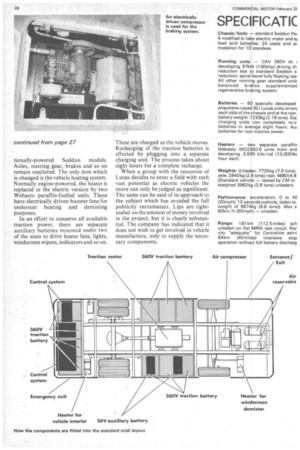SPECIFICATIC
Page 30

If you've noticed an error in this article please click here to report it so we can fix it.
Chassis/body — standard Seddon Pei 4 modified to take electric motor and si lead acid batteries. 24 seats and ac modation for 10 standees.
Running units — CAV 360V dc developing 97kW (130bhp) driving th reduction box to standard Seddon s reduction, spiral bevel fully floating real All other running gear standard uniti. balanced brakes supplemented regenerative braking system.
Batteries — 60 specially developed propolene-cased SLI Lucas units a rrani each side of the chassis and at the rear. battery weight: 1220kg 12.18 tons). Ser charging units can completely re-c. batteries in average eight hours. Aui batteries for non-tractive power.
Heaters — two separate paraffin Webasto W02350.6 units front and developing 3,500 kilo/cal CI 3,000IbE hour each.
Weights: Unladen, 7720kg (7.6 tons). axle, 2840kg (2.8 tons); rear, 4880(4.8 (Standard vehicle — tested by CM in weighed 3962kg (3.8 tons) unladen).
Performance: acceleration, 0 to 48 (30mph): 15 seconds (vehicle, laden to weight of 9874kg (9.8 tons)). Max s 80km/h (50mph) — unladen.
Range: 181 km (112.5 miles) ach unladen on flat MIRA test circuit. Rar city "adequate" for Centreline servi 64km {40 miles) intensive stop operation without full battery discharg




























































































